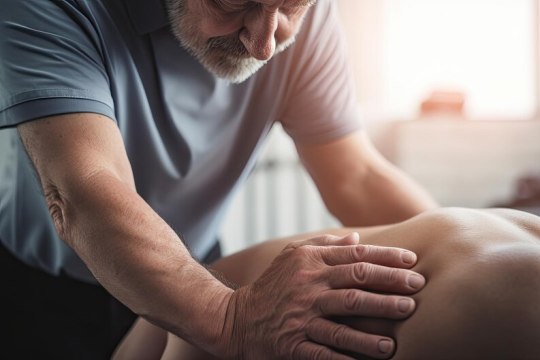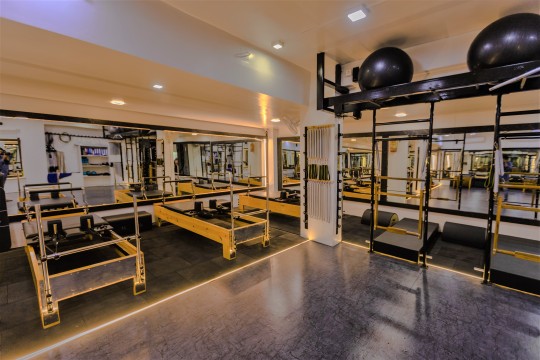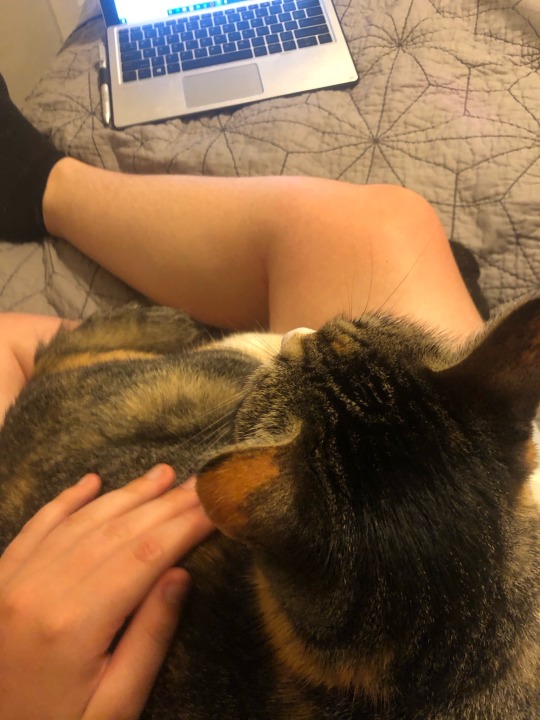#Musculoskeletal disorders
Text
there's a lot of talk about joint pain in chronic illness communities which like fair, it hurts like a bitch. but shoutout to my fellow spoonies who are painfully incapacitated by things like muscle spasticity and nerve compression. just because people can't see red, swollen, dislocated, or malformed joints doesn't make your pain not real. and extra shoutout to spoonies who deal with all these types of pain, because i know how hard it makes things.
#softspoonie#disabled#disability#spoonie#chronic pain#chronic illness#joint pain#nerve pain#muscle pain#spasticity#neuropathic pain#neurological disability#musculoskeletal disorders#fibromyalgia
1K notes
·
View notes
Text
Doctors dealing w musculoskeletal issues be like 'your [x] body part hurts? AND you have [z] pre-existing condition? Ok, this MUST be caused by [z] & I'm immediately going to treat it as such. I am not going to do anything to rule out the 10 most common causes of this type of pain, just treat this with physical therapy, but it's going to be the wrong kind because I put so little effort into figuring out what's actually wrong with you. Now :D get out of my office byeee!'
#tell me u understand#stupid-wormhole#dizzy's thoughts#hypermobility#fibromyalgia#chronic pain#chronic illness#musculoskeletal physiotherapy#musculoskeletal disorders#doctors
55 notes
·
View notes
Text
Baby I’m popping joints the rheumatologist didn’t even know existed.
13 notes
·
View notes
Text
Safeguarding the Heroes of Construction: Ensuring the Health and Safety of Building Site Workers

Safeguarding the Heroes of Construction: Ensuring the Health and Safety of Building Site Workers
In the dynamic and ever-evolving world of construction, the men and women who toil on building sites are the unsung heroes shaping our urban landscapes. However, their work comes with inherent health hazards that demand vigilant attention and robust safety measures. This article explores the critical aspects of protecting building site workers from potential health risks, emphasizing the importance of a comprehensive approach to ensure their well-being.
Personal Protective Equipment (PPE): The First Line of Defense
The cornerstone of safeguarding construction workers is the proper use of Personal Protective Equipment (PPE). Hard hats, safety glasses, steel-toed boots, gloves, and high-visibility clothing are not merely accessories; they are essential tools that shield workers from various hazards. Employers must prioritize the provision of high-quality, well-fitted PPE and enforce its consistent use on site.
Training and Education: Empowering Workers with Knowledge
Knowledge is power, and when it comes to construction site safety, education is paramount. Workers should receive comprehensive training on potential hazards, safe work practices, and emergency procedures. Regular refresher courses and toolbox talks contribute to a safety-conscious culture, empowering workers to make informed decisions and respond effectively in critical situations.
Health Monitoring and Surveillance
Regular health check-ups and surveillance programs are crucial for identifying and addressing health issues early on. Exposure to dust, chemicals, and noise on construction sites can have long-term health consequences. Implementing routine health screenings not only ensures the well-being of workers but also aids in the prevention of occupational diseases.
Air Quality Management
Airborne contaminants are a significant concern on construction sites. Dust from concrete, silicosis, and other construction materials can pose serious respiratory risks. Employers should invest in effective dust control measures such as proper ventilation, dust extraction systems, and the use of water suppression methods. Monitoring air quality regularly and providing respiratory protection when needed are essential components of a comprehensive health and safety strategy.
Noise Control Measures
Construction sites are notorious for their cacophony of heavy machinery and tools. Prolonged exposure to high noise levels can result in hearing loss and other adverse health effects. Implementing noise control measures, such as sound barriers and ear protection, is crucial. Additionally, scheduling noisy activities during designated hours and creating quiet zones can minimize the impact on workers' hearing health.
Fall Prevention and Fall Protection Systems
Falls are a leading cause of injuries and fatalities on construction sites. Implementing robust fall prevention measures, including guardrails, safety nets, and personal fall arrest systems, is imperative. Comprehensive training on the proper use of fall protection equipment and regular inspections of elevated work areas contribute to a safer working environment.

Musculoskeletal Health: Ergonomics and Manual Handling Training
The physical demands of construction work place significant stress on the musculoskeletal system. Employers should prioritize ergonomic design in tools and equipment, and workers should receive training on proper manual handling techniques. Implementing rotation of tasks and providing adequate rest breaks can mitigate the risk of musculoskeletal disorders and injuries.
Emergency Response and First Aid Training
In the event of an accident or sudden health crisis, timely and effective response is critical. All construction site workers should undergo basic first aid training, and readily accessible first aid kits should be strategically placed throughout the site. Emergency response drills should be conducted regularly to ensure that workers are prepared to handle unforeseen situations.
Conclusion
Construction site workers are the backbone of urban development, and their health and safety should be a top priority. Employers, regulators, and workers themselves play pivotal roles in creating a culture of safety that permeates every corner of the construction industry. By investing in quality PPE, providing thorough training, monitoring health, and implementing targeted safety measures, we can ensure that those who build our cities do so with confidence and well-being. After all, a safe and healthy workforce is not just a regulatory requirement; it's a moral obligation to the individuals who dedicate their skills and efforts to shaping the world around us.
Contact us :
RELATED POSTS
#safety training#constructions site#safety place#occupational safety health administration#safety#musculoskeletal disorders#Real Estate
1 note
·
View note
Text
Musculoskeletal ailments encompass a range of conditions such as Rheumatoid Arthritis (RA), Ankylosing Spondylitis (AS), Cervical Spondylosis (CS), Osteoarthritis (OA), and Lower Back Pain (LBA). Lower Back Pain, also known as Katishoola, is characterized by discomfort in the lumbar region. This condition has various origins and affects diverse population groups.
0 notes
Text

Physiotherapy
Physiotherapy is not limited to any age group or specific condition. It can benefit individuals of all ages, from infants to seniors, and those with various health concerns, including:
Physiotherapy
#Physiotherapy#Physical Therapy#Rehabilitation#Health and Mobility#Musculoskeletal Disorders#Neurological Disorders#Respiratory Conditions
0 notes
Text
Can poor heart health increase risk of carpal tunnel syndrome?
Just shows we do need to look after ourselves.
Source: Can poor heart health increase risk of carpal tunnel syndrome?
View On WordPress
0 notes
Text
#Centre for Orthopaedics#Joint Reconstruction#Sports Medicine#Orthopaedic Surgeons#Musculoskeletal Disorders
0 notes
Text
#Ortho care#Ayurveda#Musculoskeletal disorders#Joint pain#Joint stiffness#Joint mobility#Cartilage health#Bone health#Natural remedies#Herbal medicine#Physical therapy#Range of motion#Osteoarthritis#Rheumatoid arthritis
0 notes
Text
Understanding Chiropractic Care for Musculoskeletal Disorders
Chiropractic care is a form of alternative medicine that emphasises the diagnosis and treatment of musculoskeletal disorders, particularly those affecting the spine. It is a non-invasive approach that seeks to address the root cause of the problem rather than simply treating the symptoms.
Principles of Chiropractic Care
Chiropractic care is based on the principle that the body has an innate ability to heal itself, if it is functioning optimally. Chiropractors focus on the relationship between the nervous system and the spine, believing that any misalignments or subluxations can disrupt the communication between the brain and the body. This disruption can cause pain, discomfort, and reduced mobility.
Chiropractic Techniques
Chiropractors use a variety of techniques to address musculoskeletal disorders. The most common of these is the spinal adjustment, which involves the application of a controlled force to a specific joint in the spine. The adjustment is designed to correct any misalignments or subluxations, thereby restoring proper function to the affected area. This can alleviate pain, reduce inflammation, and improve mobility.
Other techniques used by chiropractors include massage, stretching, and physical therapy exercises. These are designed to loosen tight muscles, improve range of motion, and promote healing.
Benefits of Chiropractic Care
There is growing scientific evidence to support the effectiveness of chiropractic care for musculoskeletal disorders. One study published in the Journal of Manipulative and Physiological Therapeutics found that patients with lower back pain who received chiropractic care had better outcomes than those who received medical care alone.
Chiropractic care has also been shown to be effective for treating conditions such as neck pain, headaches, and joint pain. It can also be beneficial for improving athletic performance and preventing injuries.
In addition to addressing the symptoms of musculoskeletal disorders, chiropractic care can also help to improve overall health and wellness. It can promote better sleep, reduce stress and anxiety, and boost the immune system.
Risks and Limitations
Chiropractic care is generally considered safe, but there are some potential risks and limitations to be aware of. Some patients may experience mild discomfort or soreness after a spinal adjustment, but this usually resolves within a day or two.
In rare cases, spinal adjustments can cause more serious complications such as nerve damage or stroke. However, the risk of these complications is extremely low, and most patients experience only mild to moderate side effects.
It is also important to note that chiropractic care may not be suitable for everyone. Patients with certain medical conditions, such as osteoporosis or spinal cord compression, may need to avoid chiropractic adjustments.
Chiropractic care is a safe and effective form of treatment for musculoskeletal disorders. It can help to alleviate pain, improve mobility, and promote overall health and wellness. By addressing the root cause of the problem rather than simply treating the symptoms, chiropractors can help patients to achieve long-term relief from their conditions. If you are considering chiropractic care, be sure to speak with a qualified practitioner like Wellsure Chiropractic to determine if it is right for you.
0 notes
Text
I love how the word "injury" in my line of work immediately causes deep concern. Everyone knows it's a deeper, longer, more annoying process to improve or resolve these injuries, and everyone knows we're all due for them sooner or later.
#musculoskeletal disorders#repetitive stress injuries#msd#rsi#we're pushing hard to get wife fully into worker's comp asap
0 notes
Text
Musculoskeletal therapy in Kolhapur

Musculoskeletal therapy in Kolhapur is a physical therapy that helps to restore the normal function of muscles, joints and bones.
The benefits of musculoskeletal therapy in Kolhapur are:
- Improves mobility
- Reduces pain and stiffness
- Improves blood circulation
- Increases strength and flexibility
best physiotherapist in Kolhapur
best Physical therapy in Kolhapur
Physiotherapy in Kolhapur
Physiotherapist in Kolhapur
0 notes
Text
I’ve been sick for about ten years and there hasn’t been a day my chronic illness hasn’t gone out of it’s way to humble me
Like no I don’t have a ego I faint when I stand to fast and my worst enemy is water consumption
#gastroparesis#amps#amplified musculoskeletal pain syndrome#pots syndrome#posturaltachycardiasyndrome#fibromyalgia#chronic migraine#chronic migraine disorder#chronic illness#spoonie#out of spoons
98 notes
·
View notes
Text
In case those of you who are in recovery need some motivation, this is a photo of the first time in months that Iv been able to let my cat sit in my lap because of my disabilities!

#amps#amplified musculoskeletal pain syndrome#fnd#functional neurological disorder#pretty cats#recovery#making progress#it’s not much but it’s something#this means a lot to me
20 notes
·
View notes
Text
Okay so apparently the "pain" that my physical therapists and doctors have been telling me to push through while exercising this whole time was MUSCLE SORENESS? freaking *muscle soreness* are you kidding me??
WHY would anyone not know that exercising causes muscle soreness? I have ehlers danlos syndrome, not "I've never used a muscle before because it hurts too much" syndrome. That's expected pain. I am already pushing through that because I'm not an idiot, I know how exercise works. That just seems so condescending.
When I bring something up, it's because either something hurts at a 7 on the pain scale or above, I'm having unusual pain or discomfort, or I can physically feel my joints moving in and out of socket in a way that makes the exercises not even engage my muscles at all. But apparently I'll have to specify that next time I see a doctor -_-
#also im sorry im just very worked up and this isnt targeted at people who do have muscle dysfunction disorders#like im sure you also are experiencing more than simply muscle soreness too though#so im sorry if doctors say this shit to yoy guys too#omg imagine telling someone with a muscular disorder to just work out more and push through some pain#i guess eds is actually a musculoskeletal dosorder 0.0 i forget that#grr im so mad why are doctors like this#i dislocate joints everyday im not gonna complain about muscle soreness#my muscles are already in spasm 90% of the time and i honestly cant afford to care
27 notes
·
View notes
Text
The Doctor Shopper
Doctor after doctor,
Day after day,
I still beg for help,
yet each time they say:
Here are some probiotics!
I really think you should try them.
You have migraines, so here's some magnesium oxide!
I couldn't be caught "refusing treatment" so my hands are tied.
Take a multivitamin,
The cure to all that ails you.
More fiber, maybe Benefiber,
But you may have fructose intolerance so not fruit smoothie fiber.
Your ankles aren't weak.
Your ankles don't roll.
You're autistic,
You're dyspraxic.
I wonder if that's really all.
I would like a new doctor,
but randos on the internet claim,
Stop switching around!
You should stop "doctor shopping."
"I don't think that they're hallucinations!"
Nope, just auras to migraines.
Also, I'm autistic.
Everything is interpreted as scary when you're autistic.
He's a nutjob,
I'd like a new doc! I want to switch but I don't
out of fear of claims of doctor shopping.
The yellow dots are chasing me!
No, visual auras which autism made scary. Clawing and cutting out the spiders in my blood my skin my brain.
No, tingling auras made scary by the autism.
Should a doctor really be this stupid?
The psychologist in the room, she didn't say anything!
Would getting a new doctor
really be doctor shopping?
I couldn't possibly have EDS.
Nope, my doctor has a connective tissue disorder.
I'm not more hypermobile than thee,
so an Ehlers Danlos diagnosis must not be for me.
"You have AMPS!"
"You have IBS!"
"You are fat!"
"Drink water and get more exercise!"
I won't be a doctor shopper.
I can't help but wonder,
is wanting to be believed
really shopping for a doctor?
A fat female teen,
symptoms of nausea, pain, dizziness, and more.
The most obvious option is mental illness.
The best prescription is weight loss.
My attempts at exercise
are extinguished by my pain.
I can't keep on,
but there's no help
until I'm the one to fix it all.
I fantasize every day
of growing up, losing some weight.
Building a ton of muscle, drinking gallons of water a day.
Taking my vitamins and supplements like some kind of health freak.
Walking into their office,
"I'm not cured!"
I'm falling, I'm swelling, I'm hurting, I'm crying.
Help me, please.
Are these thoughts normal?
They don't feel normal.
I should be fixed. I could be fixed.
Drugs, therapy again, more drugs (What mood stabilizer is it now?)
Maybe one day my pain will be taken seriously.
Maybe one day my quality of life will be taken seriously.
Maybe one day I will be taken seriously.
That day's not today, I wish I was okay, but I can't handle it.
If I question it...
Question their years of medical knowledge...
Question their schooling...
Question their authority...
I'm the bad guy who's looking to shop for a doctor.
#medical gaslighting#not believed#chronic pain#chronic illnes#i want to be happy#i want to be pain free#autistic#autistic disabled#physically disabled#hypermobility spectrum disorder#hypermobility syndrome#hypermobile#migraine#joint pain#cane user#amps#amplified pain#amplified musculoskeletal pain syndrome#spoonie#a poem#poetry#poet#a poem by me#i wrote this poem#this is my poetry
2 notes
·
View notes